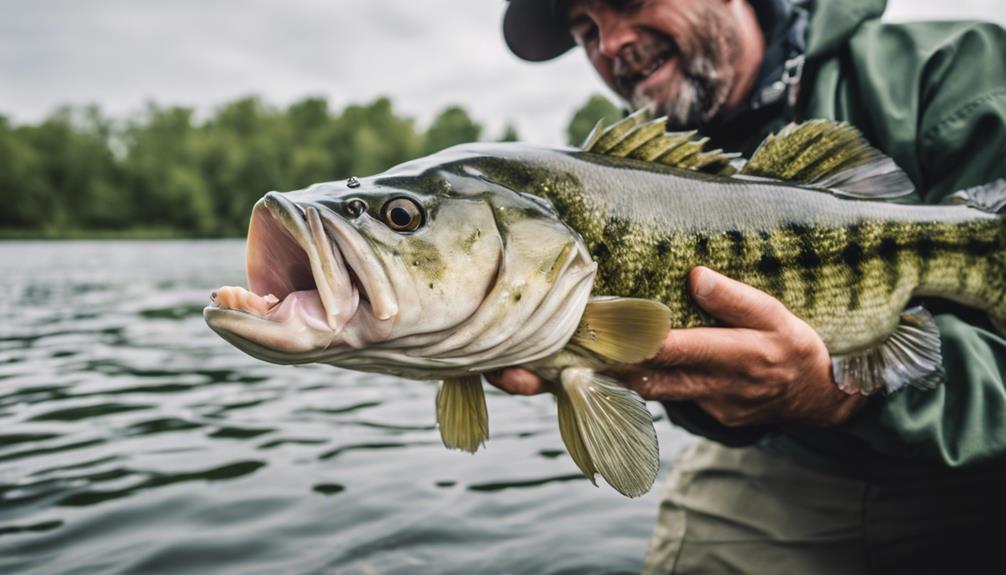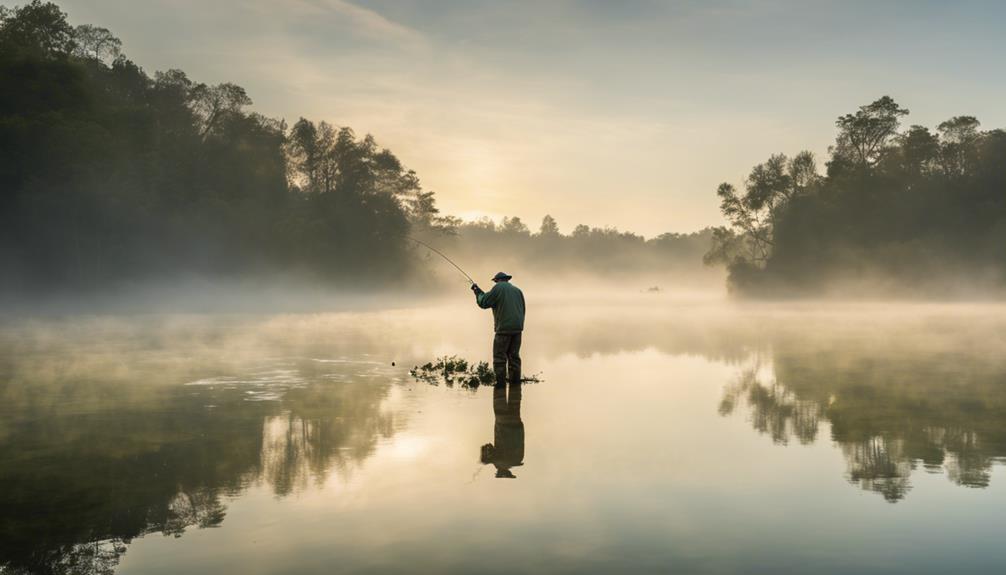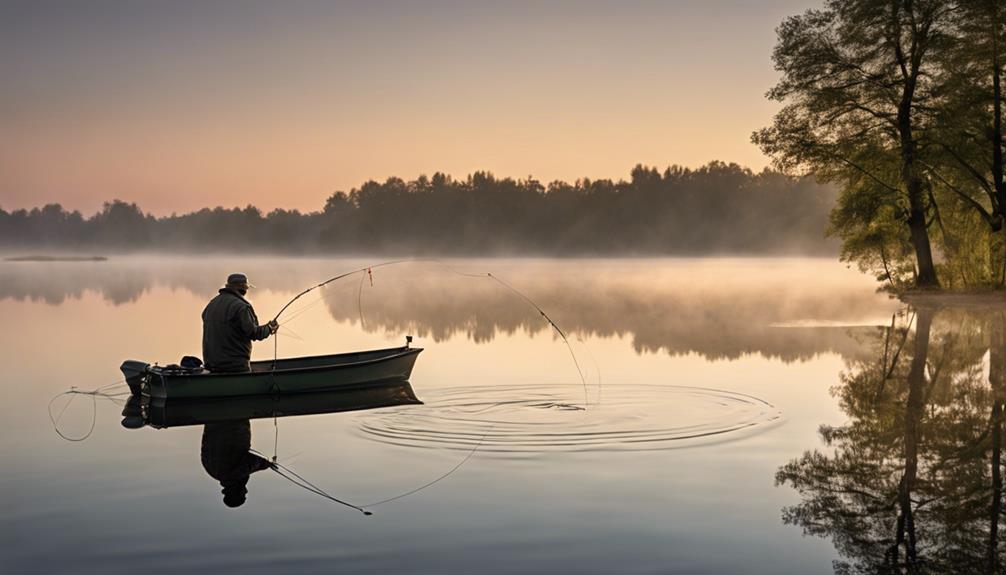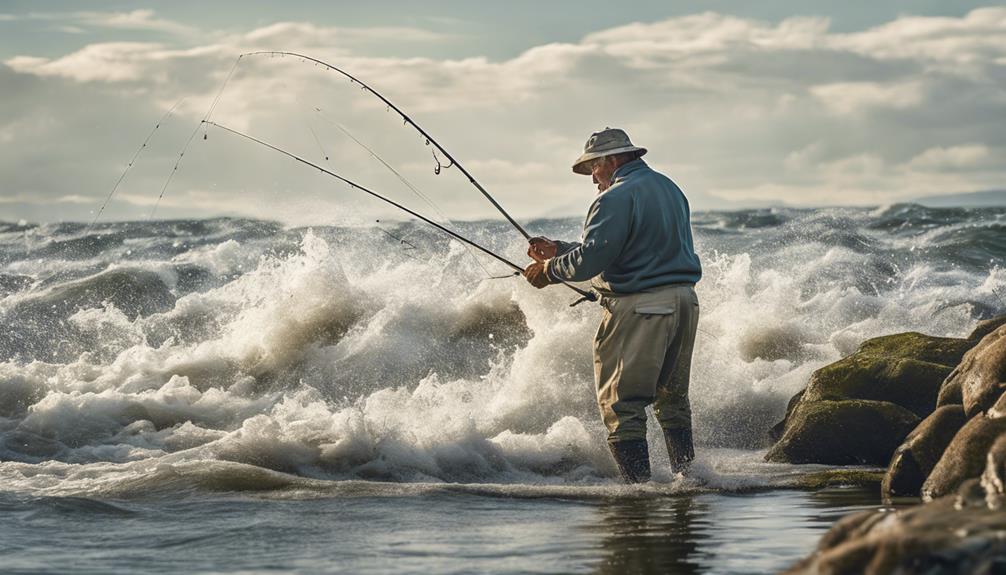When it comes to freshwater bass fishing, over 60% of anglers consider bass fishing their top choice. Imagine the satisfaction of landing that elusive trophy bass after applying essential techniques.
From selecting the right gear to understanding bass behavior, each aspect plays a crucial role in your success on the water. Whether you're a novice angler looking to improve your skills or a seasoned pro seeking to refine your techniques, mastering freshwater bass fishing is a rewarding journey worth embarking on.
Selecting the Right Gear
When gearing up for freshwater bass fishing, ensure you have the right equipment to increase your chances of success. Proper sizing of your gear is crucial. Make sure your rods, reels, lines, and lures are appropriate for the size of bass you're targeting. Using gear that's too light can result in losing fish, while gear that's too heavy may not provide the right level of sensitivity needed to detect bites effectively.
Gear maintenance is another key aspect to consider. Regularly clean and inspect your equipment to ensure it's in good working condition. This includes checking for any signs of wear and tear, such as frayed lines or rusty hooks. By keeping your gear well-maintained, you can prevent unexpected failures while out on the water.
When it comes to budget considerations, it's essential to find a balance between cost and quality. While it may be tempting to opt for the cheapest gear available, investing in higher-quality equipment can ultimately save you money in the long run. Upgrading to quality rods, reels, and lures can improve your performance and durability, leading to a more enjoyable and successful fishing experience. Remember, having the right gear can make all the difference in your freshwater bass fishing adventures.
Understanding Bass Behavior
To increase your success in freshwater bass fishing, understanding bass behavior is essential for effectively targeting and catching these elusive fish. Bass exhibit specific feeding patterns, habitat preferences, seasonal movements, and triggers of aggression that can help you become a more successful angler. Here are some key points to consider:
- Feeding Patterns: Bass are opportunistic feeders, often preying on smaller fish, insects, and crustaceans. Understanding what they're feeding on in a particular body of water can help you choose the right lures and baits to entice strikes.
- Habitat Preferences: Bass are structure-oriented fish, seeking cover in vegetation, rocks, fallen trees, and other underwater structures. By learning to identify these preferred habitats, you can increase your chances of locating bass and presenting your bait where they're most likely to be.
- Seasonal Movements and Aggression Triggers: Bass behavior changes with the seasons. They move to different depths and locations in response to temperature changes, spawning cycles, and food availability. Knowing how these factors influence bass behavior can help you anticipate where they'll be and what techniques will trigger strikes.
Perfecting Casting Techniques
Mastering the art of precise casting is crucial for achieving success in freshwater bass fishing. To improve your casting techniques, focus on precision accuracy and distance casting. Before casting, ensure your line control is tight to prevent tangling and maximize your casting distance. Practice different casting techniques to become adept at placing your lure exactly where you want it to be. Experiment with adjusting your reel speed to match the weight of your lure for optimal casting performance.
When casting, pay attention to your wrist movement and release timing. A smooth and controlled casting motion will help you achieve better accuracy when targeting specific areas where bass may be hiding. Remember that accuracy is key when trying to entice bass to strike. By mastering your casting skills, you can effectively present your lure in a natural and appealing way to entice bass into biting.
In addition to accuracy, mastering distance casting is essential for reaching bass in various locations, such as under overhanging branches or in deeper waters. Practice casting at different distances to hone your skills and increase your chances of reaching bass in hard-to-reach spots. With patience and dedication to perfecting your casting techniques, you'll be well on your way to becoming a successful freshwater bass angler.
Mastering Different Lures
Practice using various lures to expand your skills and increase your chances of catching freshwater bass. Different lures are effective in various situations, and mastering them can significantly enhance your fishing experience. Here are some key techniques to consider:
- Topwater Action: When using topwater lures, focus on creating enticing movements on the water's surface to attract bass. Experiment with different retrieval speeds and pauses to see what triggers strikes. Remember, bass are often drawn to the commotion and ripples created by these lures.
- Jig Fishing: Jigs are versatile lures that can mimic various types of prey. Practice casting jigs near structures like rocks, docks, or vegetation, as bass tend to hide in these areas. Work the jig by hopping it along the bottom to imitate a natural movement that entices bass to strike.
- Crankbait Tactics: Crankbaits are excellent for covering water quickly and locating active fish. Experiment with different diving depths and speeds to find the right combination that entices bass. Vary your retrieval techniques by pausing, twitching, or speeding up the crankbait to trigger strikes.
- Spinnerbait Secrets: Spinnerbaits are effective in murky waters or low-light conditions. Play around with blade combinations, colors, and sizes to see what works best in your fishing environment. Try different retrieves, such as slow rolling, burning, or yo-yoing the spinnerbait to attract bass effectively.
Fine-Tuning Retrieval Methods
Explore the nuances of adjusting your retrieval methods to maximize your success in freshwater bass fishing. When fine-tuning your retrieval techniques, consider adjusting speed and depth to entice bass effectively. Bass are known to react differently to various retrieval speeds, so experiment with slow and fast retrieves to see what triggers more strikes. Varying the depth at which you retrieve your lure can also make a significant difference. Try fishing at different depths to find where the bass are most active on any given day.
In addition to speed and depth adjustments, experimenting with pauses and jerks in your retrieval can be game-changers. Adding pauses to your retrieve can mimic injured prey, enticing bass to strike. Try incorporating sudden jerks or twitches to make your lure appear more lifelike and trigger aggressive strikes from nearby bass. These sudden movements can often mimic a baitfish trying to escape, making it irresistible to hungry bass.
Navigating Water Structures
When fishing for freshwater bass, understanding how to navigate water structures can significantly enhance your chances of success. To maximize your fishing efficiency, consider the following key strategies:
- Structure Mapping: Before casting your line, take the time to map out the underwater structures in the area. Look for submerged logs, rocks, vegetation, and drop-offs, as these are prime locations where bass tend to hide. By understanding the layout of the underwater terrain, you can strategically position your bait for optimal success.
- Bait Placement: Once you've identified the key structures, it's essential to place your bait strategically. Experiment with different depths and angles to see where the bass are most active. Remember that bass are ambush predators, so placing your bait near cover or structure increases the likelihood of a successful strike.
- Current Analysis, Depth Exploration: Pay attention to the water currents and depths as you navigate the water structures. Bass often position themselves where they can conserve energy while waiting for prey. By analyzing the current flow and exploring different depths, you can target areas where bass are likely to be feeding.
Handling Bass Properly

Navigating water structures successfully also involves knowing how to handle bass properly once you've hooked them. Proper handling of bass is crucial for their well-being and the sustainability of fishing practices. When you land a bass, ensure you wet your hands before handling them. This helps protect their delicate skin and scales, preventing damage and potential infections. Additionally, avoid squeezing the fish tightly or touching their gills, as this can harm them.
Fish safety is paramount when it comes to handling bass. Keep the fish close to the water's surface to minimize their time out of the water. If you need to unhook the bass, do it quickly and gently, using proper tools like needle-nose pliers to avoid causing unnecessary harm. When practicing catch and release, employ proper release techniques. Hold the bass in the water facing upstream until it swims away on its own, ensuring it has fully recovered from the fight.
To promote sustainable fishing practices, always prioritize the well-being of the bass you catch. By handling them properly and releasing them safely, you contribute to the conservation of bass populations in freshwater ecosystems. Remember, responsible fishing includes not just the thrill of the catch but also the care for the fish and their environment.
Practicing Catch and Release
To promote conservation efforts and ensure the well-being of bass populations, mastering the art of catch and release is essential for freshwater anglers. By following conservation ethics and practicing proper handling techniques, you can contribute to sustainable fishing practices and minimize the environmental impact on bass habitats.
When engaging in catch and release, remember these key points:
- Handle with Care: When handling bass, make sure your hands are wet to protect their delicate slime layer. Avoid using dry hands or rough surfaces that can damage their skin. Treat them gently to minimize stress and potential injuries.
- Use Barbless Hooks: Opt for barbless hooks to make hook removal easier and less harmful to the fish. This simple switch can significantly reduce the stress and injury bass may experience during the catch and release process.
- Minimize Air Exposure: Keep the bass in the water as much as possible. Limiting air exposure helps prevent issues like barotrauma, a condition where fish struggle to adjust to pressure changes, which can be fatal if not managed properly.
Frequently Asked Questions
How Can I Effectively Locate Bass in Murky or Stained Water Conditions?
To find bass in murky water, focus on lure selection and casting accuracy. Use bright or noisy lures to attract their attention. Opt for a high-visibility line to track your bait.
Vary your retrieve speed to entice strikes. Remember, in stained conditions, bass rely more on sound and vibration to locate prey, so make your presentation stand out. Stay patient and experiment with different techniques until you find what works best in these challenging conditions.
What Are Some Advanced Techniques for Targeting Trophy-Sized Bass?
When targeting trophy-sized bass, it's crucial to use advanced techniques like topwater tactics and precise lure selection. Big bass strategies often involve focusing on fishing around structures where these large fish like to hide.
How Can Weather Patterns Impact Bass Behavior and Feeding Habits?
Weather influences bass behavior and feeding patterns significantly. Changes in weather conditions such as temperature, barometric pressure, and cloud cover can impact where bass are located in the water and how actively they feed.
Understanding the correlation between weather patterns and bass behavior is crucial for successful fishing. By adapting your techniques to match the current weather conditions, you can increase your chances of hooking a big one.
Are There Any Specific Tips for Fishing in Heavily Pressured Bass Fishing Areas?
When fishing in heavily pressured bass areas, you need to get strategic. Opt for natural-looking lures to outsmart those cunning bass. Focus on your presentation tactics to mimic real prey and trigger more strikes.
Scout for ambush points where bass hide, like fallen trees or vegetation. Use stealth techniques to approach quietly and avoid spooking the fish.
How Can I Improve My Ability to Detect Subtle Bites and Strikes While Fishing for Bass?
To improve your ability to detect subtle bites and strikes while bass fishing, focus on sensitivity training. Pay attention to strike indicators and work on your reaction time. By honing these skills, you'll be better equipped to feel even the slightest nibble and react quickly to set the hook.
Practice regularly to develop a keen sense of bite detection, which is crucial for successful bass fishing in any scenario.
Conclusion
Now that you've learned the essential techniques for freshwater bass fishing, it's time to put your knowledge into practice. Remember to select the right gear, understand bass behavior, perfect your casting techniques, master different lures, fine-tune retrieval methods, navigate water structures, handle bass properly, and practice catch and release.
With dedication and practice, you'll soon become a master angler in the world of freshwater bass fishing. Good luck on your fishing adventures!



